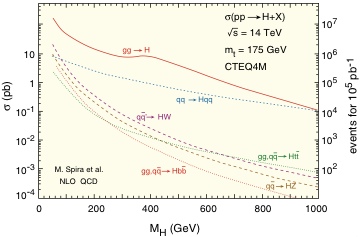| ||||||||||||||||||||||||||||||||||||||
Standard Model Higgs Boson | ||||||||||||||||||||||||||||||||||||||
In the Minimal Standard Model (MSM), the Higgs boson is an excitation of the non-zero Higgs field that fills all of the universe. The word minimal implies that the Higgs sector has the fewest degrees of freedom to do the job of spontaneously breaking the SU(2)xU(1) gauge symmetry of the model (and producing masses for the gauge bosons and fermions). Unfortunately, the MSM still contains some pathologies and the word minimal is not necessarily equivalent to the word correct. Many Standard Model extensions and alternatives contain Higgs bosons. The JHU theory group studies some of these possibilities. In particular, Professor Kaplan has recently one alternative called little Higgs. At the LHC, the Higgs boson is produced dominantly via gluon-gluon fusion. It is also produced less copiously in association with light quarks, top quarks and gauge bosons. The actual sizes of the cross sections (production rates) depend upon the (unknown) mass of the Higgs: | ||||||||||||||||||||||||||||||||||||||
 | ||||||||||||||||||||||||||||||||||||||
 | ||||||||||||||||||||||||||||||||||||||
The branching ratios of the Higgs are also sensitive to its mass. It always prefers to decay into the heaviest particles that are kinematically allowed. For most of the theoretically preferred mass range, the b-bbar final state dominates. Unfortunately, b-bbar pairs are produced copiously by ordinary processes and the b-bbar mass resolution is poor as compared with the intrinsic Higgs width. |  | |||||||||||||||||||||||||||||||||||||
 | ||||||||||||||||||||||||||||||||||||||
However, b-bar final states may be useful in searching for Higgs bosons produced in association with gauge bosons like the W: The golden search mode for light Higgs (MH<2MW) is the rare decay into 2 photons (g) which has relatively small backgrounds and high mass resolution: | ||||||||||||||||||||||||||||||||||||||
 | ||||||||||||||||||||||||||||||||||||||
If a Higgs candidate is discovered at the LHC, the immediate questions will be: 1) Are its couplings + decay modes standard or do they suggest the richer Higgs sector suggested by many Standard Model extensions? 2) Does it have heavier siblings? | ||||||||||||||||||||||||||||||||||||||
The discovery of a Higgs boson at the LHC will signal the beginning of an exciting period in particle physics! | ||||||||||||||||||||||||||||||||||||||
| ||||||||||||||||||||||||||||||||||||||

